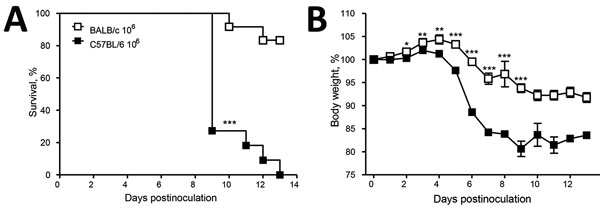Emergomyces africanus in Soil, South Africa
Ilan S. Schwartz

, Barbra Lerm, J. Claire Hoving, Chris Kenyon, William G. Horsnell, W. Joan Basson, Patricia Otieno-Odhiambo, Nelesh P. Govender, Robert Colebunders, and Alfred Botha
Author affiliations: University of Manitoba, Winnipeg, Manitoba, Canada (I.S. Schwartz); University of Antwerp, Antwerp, Belgium (I.S. Schwartz, R. Colebunders); Stellenbosch University, Stellenbosch, South Africa (B. Lerm, W.J. Basson, A. Botha); University of Cape Town, Cape Town, South Africa (J.C. Hoving, C. Kenyon, W.G. Horsnell, P. Otieno-Odhiambo, N.P. Govender); Institute of Tropical Medicine, Antwerp (C. Kenyon); University of Birmingham, Birmingham, UK (W.G. Horsnell); CNRS-University of Orleans and Le Studium Institute for Advanced Studies, Orléans, France (W.G. Horsnell); National Institute for Communicable Diseases, Johannesburg, South Africa (N.P. Govender)
Main Article
Figure 2

Figure 2. Infection of mice with Emergomyces africanus. In a proof-of-principle study, C57BL/6 and BALBc mice were inoculated intraperitoneally with 106 conidia (Es. africanus CAB 2141, a clinical isolate) in saline. Mice were weighed and monitored twice daily for distress. Both mouse strains had symptom onset, with C57BL/6 mice showing significantly more severe disease pathophysiology in response to the high dose of Es. africanus (demonstrated by reduced survival and increased weight loss). Data represent 2 pooled experiments (n = 8 [panel A] and n = 2 [panel B] combined), mean +SD of the mean. p values were determined by using unpaired 2-tailed Student t-test or 1-way analysis of variance using a Bonferroni posttest (GraphPad Prism version 5). Values of p<0.05 were considered significant. *p<0.05; **p<0.01; ***p<0.001 (C57BL/6 compared with BALB/c mice).
Main Article
Page created: January 17, 2018
Page updated: January 17, 2018
Page reviewed: January 17, 2018
The conclusions, findings, and opinions expressed by authors contributing to this journal do not necessarily reflect the official position of the U.S. Department of Health and Human Services, the Public Health Service, the Centers for Disease Control and Prevention, or the authors' affiliated institutions. Use of trade names is for identification only and does not imply endorsement by any of the groups named above.
